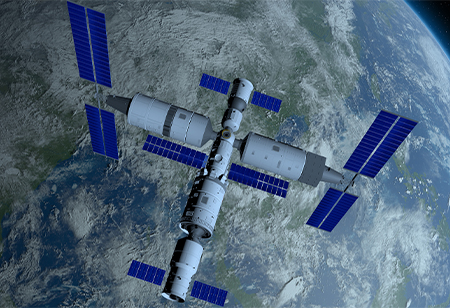
China Expands Tiangong Space Station as ISS' Successor


China is expanding its Tiangong space station as the NASA-led International Space Station (ISS) approaches the end of its life. The Chinese space station’s expansion from three to six modules over the next several years, could give astronauts from other countries a different platform for near-Earth missions. China’s Tiangong, or Celestial Palace, space station has been fully functioning since late 2022 and can accommodate up to three astronauts at an orbital altitude of up to 450 kilometers (280 miles).
First Endeavor to Space in 1970
In 1970, China launched its first satellite as the country was experiencing the severe effects of the Cultural Revolution. At that point, the US, the Soviet Union, France, and Japan were the only other spacefaring nations.
China has launched more than 200 rockets in the last ten years.
It has already deployed the unmanned Chang'e 5 mission to the Moon to gather and return rock samples. The Chinese flag, which was purposefully larger than previous US flags, was put on the lunar surface.
As of Shenzhou 14, China has launched 14 astronauts into space, compared to the US's 340 and the Soviet Union's (and now Russia's) more than 130.
However, there have been obstacles. Two launches failed in 2020, and a piece of a Chinese rocket fell out of orbit and plummeted into the Atlantic Ocean in 2021.
Tiangong Carries the Weight of China’s Aspirations
Known as Tiangong, which means ‘Heavenly Palace’, the nation launched Tiangong-1 and Tiangong-2, two temporary test space stations.
For Tiangong-1, the majority of the essential functions of the space station, such as the power, propulsion, guidance, navigation, and life support systems, are provided by this, along with residential accommodations for three crew members. Additionally, the Tianhe module contains a Chinarm robotic arm.
The second of three crucial components for Tiangong is the new lab Wentian.Researchers can carry out zero-gravity experiments inside the pressurized environment of the Wentian scientific module. In April 2021, the first major module, called Tianhe, which houses crew members' living quarters, was launched into orbit. By the end of 2022, Mengtian Science Lab, the other important module, is scheduled to launch.
The third module of Tiangong, Mengtian, was primarily created for scientific studies. When it launched, it contained a number of cutting-edge physics experiments, including a facility that China claims can produce the universe's coldest matter. On November 3, 2022, Mengtian was put into orbit and docked with the remainder of the space station.
For Tiangong, China has high aspirations. The station will be self-sufficient in terms of electricity, propulsion, life support, and living space. It is also intended to give China's new Xuntian space telescope, which will orbit the space station next year, the power it needs to recharge.
Tiangong is intended to take the role of the International Space Station (ISS), which will be shut down in 2031. Since US law forbids its space agency, NASA, from sharing its data with China, Chinese astronauts are now prohibited from participating in the ISS.
After being cut off from the ISS, Tiangong has evolved into a symbol of China's expanding influence and confidence in its space activities, as well as a rival to the US in the field.
US law prohibits it from working directly or indirectly with NASA.
Main Goal
The Tiangong station's primary purpose is to conduct research on space living. More than 1,000 experiments are planned during the next 10 years with an emphasis on understanding the growth and development of many types of plants, animals, and microbes.
Tiangong and the science carried out there will support China's future space missions, despite the new station being smaller than the 16 modules of the International Space Station. China intends to launch the Xuntian space telescope in December 2023. With a resolution almost equivalent to that of the Hubble Space Telescope but a broader field of vision, this telescope will scan stars and supermassive black holes among other tasks. Periodically, the telescope will dock with the station for upkeep.
To return samples to Earth, China also intends to send numerous missions to Mars as well as nearby comets and asteroids. The project has no specific deadline, but China and Russia have declared plans to create a joint Moon station. This is possibly the most significant development.
Commercialization
Observing how China uses Tiangong develops will provide us hints about potential commercial and international participation.
Another development that may have an impact on how people think about and approach China's space station is the country's fledgling commercialization initiatives, which include putting out a request for a commercial resupply proposal.
The types of companies vying for CSS contracts could be revealed during China's upcoming five-year plan period (2026–2030).
These adjustments might increase transparency and make it possible for more accurate independent evaluations. The PLA's influence over the space industry and perceptions of how independent Chinese commercial businesses are from state-owned organizations will both play a role.
Many other nations are attempting to reach the Moon at the same time that China increases its involvement in space.
How are Other Countries Progressing?
NASA has already rolled out its new massive SLS rocket at the Kennedy Space Center and expects to send humans from the US and other nations back to the Moon starting in 2025.
Other countries working on their own moon missions include Japan, South Korea, Russia, India, and the United Arab Emirates.
India aspires to construct its own space station by 2030 and has already launched its second significant Moon mission.
A network of lunar satellites is also being planned by the European Space Agency, which collaborates with NASA on Moon missions and will make it simpler for astronauts to interact with Earth.

